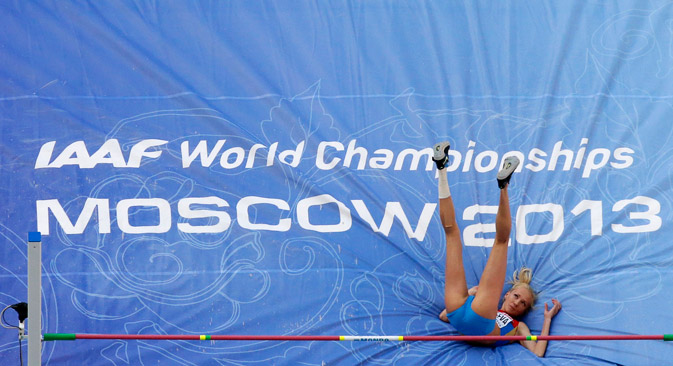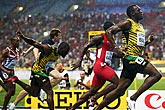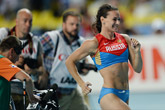Reliving feats from the World Athletics Championships

Svetlana Shkolina won the gold medal in the high jump. Source: Reuters
The World Athletics Championships held in Russia's capital produced many memorable scenes: Russian runners sharing a symbolic kiss after their victory in the 4x400 meter relay; Usain Bolt on the starting blocks directing a prayer toward the stormy skies before the 100-meter finals; naturalized British athlete Mohamed Farah grabbing his head with both hands after winning the 10k; the golden flight of Ukrainian Bogdan Bondarenko at a record 2.41 meters…
The main event at the world championships was Russia's first place in the unofficial medal count. Russia's seven gold medals were won by Alexander Ivanov and Yelena Lashmanova in race walking, Yelena Isinbaeva in pole vaulting, Tatiana Lysenko in the hammer throw, Alexander Menkov in the long jump, Svetlana Shkolina in the high jump, and the women's 4x400 meter relay team.
In Russian head coach Valentine Maslakov’s opinion, seven gold medals was not the limit for Russian athletes. “We could have won a few more gold medals,” said Maslakov. “We had chances for both men and women in the javelin.
The Abakumov family could have left the championship with two gold medals instead of bronze. Maria Savinova was the obvious favorite for the 800-meter, but was not fully prepared for the final race. Ivan Ukhov could have counted on a medal in the high jump.
A result of 2.35 is very strong, but the new generation of jumpers is already prepared to jump 2.40 or higher. But the one who made me the happiest is Alexander Menkov. He won his event with room to spare and with great confidence. Bravo.”
The public began to show interest in the championships only in the final four days. The Luzhniki stadium was sold out by 6 p.m., and obnoxious scalpers raised their prices to $200. According to the new high-jump world champion Svetlana Shkolina, it was the crowd that helped her win gold.
“The support at Luzhniki was just crazy. When I jumped, the entire stadium chanted my name,” said Shkolina. “That was a first for me. I am sure that this gave me more confidence, and I conquered 2.03 [meters]. Before the start, I had problems with my back, with my mood, with everything. I had emotional ups and downs, but my coach was able to help me. I really enjoyed how the championships were organized — I'll remember these championships for a long time.”
In the first days of the championships, not many tickets were sold at Luzhniki. Local law enforcement was partly to blame. The streets of Moscow looked unusually deserted during the women's and men's marathons. The world's best athletes ran in 86-degree heat along empty embankments, where the only spectators were police and voluntary security personnel baking in the sun.
This rather serious wrinkle was smoothed over by the unlikely stories of the Moscow competition, which will remain forever in the archives of athletics.
For example, the silver won by Italian Valeria Straneo is a story of overcoming huge obstacles with illness and physical limitations. She came in second in the marathon, at the age of 37, which has never been done before.
Straneo was born with spherocytosis — a genetic disease that causes anemia and problems with red blood cells. In 2010, Valeria began to have new challenges that could have caused her to forget about the sport forever; she had an operation to remove her spleen.
After such a serious surgery, Straneo quickly recovered and started to run faster. In 2011, she shaved 15 minutes off of her personal record in the marathon, set off for the Olympics and came in eighth place. Straneo triumphed in Moscow with her second-place win, which, in her case, is as good as winning gold.
At the shot put event, a photographer unexpectedly became a hero. Reuters photographer Kai Pfaffenbach changed his camera angle by laying on his stomach and was taking, it seemed, typical shots for these types of events. “I wasn't taking the best shots, but soon found out that five photos that I took became the most important in my career,” said Pfaffenbach. “The photos of Usain Bolt can't even compare.”
Related:
Athlete denies kissing team member in protest against anti-LGBT law
Russia aims to outdo US at athletics championship
Video: Usain Bolt wins 100m title as World Athletics Championship picks up in speed
This is what happened: In German athlete David Storl’s first attempt, judges ruled that he had stepped beyond the barrier and committed a foul. Storl was shocked and argued with the judges, but the judges would not count the attempt. Seeing this, Pfaffenbach looked through his photos and said to Storl: “I don't think there was any foul.”
Storl immediately brought the main judge to the photographer. The judge looked at the photo several times and, in the end, agreed that there was no foul, and the throw was counted. Thirty minutes later, it was announced that the throw brought Storl victory.
Kenyan Julius Yego ended up one step short of bronze in the javelin throwing event, but his story amazed the sports world. Yego never had a professional trainer: He taught himself by watching YouTube videos in an Internet cafe and later throwing the javelin in a field, gradually honing his technique.
In the end, the Kenyan lost to Russian Dmitri Tarabin by only a couple of centimeters and was inconsolable after the results were announced. Now the athlete will have to wait for the Olympic Games in Rio, which is sure to bring sports enthusiasts more amazing new stories and images.
All rights reserved by Rossiyskaya Gazeta.
Subscribe
to our newsletter!
Get the week's best stories straight to your inbox

